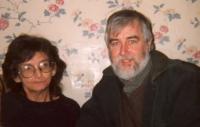
November 16, 2010

Linda Scarberry and Loren Coleman, 2001.
On November 15, 1966, the World was introduced to the phenomenon that would become known as Mothman. After the first sighting reported by the press 44 years ago in the papers of the day, soon a copyeditor in Ohio, a fan of the “Batman” series then on television, would coin the word “Mothman” because it fit in the headlines better. The sightings of a “Big Bird” had become a “big insect” with one copyeditor’s action.
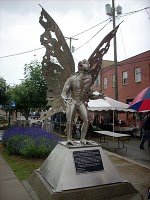
The ultimate modern embracing of the wrong visual for Mothman occurred in Point Pleasant, West Virginia, where the “moth” science fiction imagery won out over the more correct “avian” cryptid descriptions.
Mothman was born. But the world is slowly changing the story. A movie came out in 2002, and since then, the great Mothman chronicler John A. Keel has died.
Still, Mothman is remembered and what it really looked like is debated.
November 27 is another milestone in the 44th year anniversary of events related to Mothman and its impact on a historical understanding of its appearance.
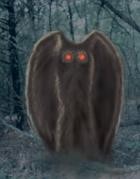
On November 27,1966, at around 10:30 a.m., Connie Jo Carpenter sighted what she took to be Mothman near New Haven, West Virginia. The creature looked to be a tall gray winged figure, standing on the local golf course. She said the “very red eyes” were “horrible, like something out of a science fiction movie,” but could not give a detailed description of the face of the creature.
Carpenter’s Mothman unfolded its wings, which appeared to be ten feet across, and flew directly at her automobile’s windshield. It then flew off and vanished. Following Carpenter’s sighting, she found her own eyes were red, swollen, and itchy for a half month.
The night of this same day, in St. Albans, West Virginia, thirteen-year-old Sheila Cain and her sister were walking home when they saw Mothman standing by a local road. They said it appeared to be gray & white and seven feet tall, with big red eyes. They grew panicky, let out some screams, and hightailed it home, telling worried adults later that Mothman had flown low over their heads as they ran.
(Source: John A. Keel, FSR, July-August 1968, pp. 8 and 13.)
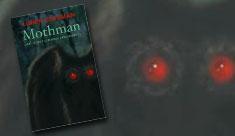
When I first shared information here on the 40th anniversary of the first “media-acknowledged” sightings, Mothman Museum founder John Frick disagreed with me. Here’s equal time for his view:
John Frick writes that it is “not true,” regarding my comment, in my previous posting that during re-interviews in the “21st century (especially since 2002), for books, documentaries, and news clips, the Mothman has become a fully humanized creature with a head, arms, and legs that were not there in the first reports.” He continues:
This from the November 16, 1966 Point Pleasant Register: “It was like a man with wings” Mallette said.”It wasn’t like anything you’d see on tv or in a monster movie”
They said it did not resemble a bat in any way but “maybe what you would visualize as an angel”
From the November 18, 1966 Athens Messenger: The description includes two red eyes about six inches apart, wings with 10 foot span and always manlike with stocky legs.
From a newspaper around November 21: Miss Connie Jo Carpenter, 18, New Haven, saw the awful looking creature flying toward her car on route 33 near New Haven, about 10:30 AM. She said the thing was “man-like, with a big wing span.” (Keep in mind that Connie saw it during the day.)
From the same paper:
Later Sunday night, two young girls reported seeing a similar man-like creature on route 60, near St Albans. The girls said the flying creature had “big red pop eyes and didn’t have a beak.”
So there it is, the man-like appearance of Mothman has been there right from the very beginning. The only point I concede on here is that a full human head has been added in many of the pop culture depicitions (the statue, the flying Mothman seen on tv now hanging in the museum, the T-shirts, etc), but Connie Carpenter did say early on that it had a science fiction like face, so reports of a head were there early on. Yes there was also sightings of a giant bird (less frequently than Mothman and obviously a form of Thunderbird), by Tom Ury and others in WV that year, but nearly every other major phenomena you can think of was also occurring there (bigfoot, UFOs, aliens, MIB, poltergeists, prophecy, etc). One guy I talked to this year saw an 8 foot hairy man like creature (without wings) around 1968 out at TNT, and he assumed it was Mothman, but what he didn’t realize was that this was just the phenomena manifesting as a BHM (big hairy monster), which incidentally consistently fools bigfoot hunters into thinking bigfoot is a real creature on the east coast. Reporter Mary Hyre also had reports of bigfoot around TNT and Point Pleasant in the late ’60s. Anyway, clearly when you look at all the early descriptions of what they call Mothman, it was more man than bird. Unfortunately propaganda by Mark Hall, Robert Goerman, Coleman, and maybe others trying to counter these facts seems to be ongoing. No – Mothman was not a large bird, and it certainly isn’t what Mark Hall refers to as the very laughable Big Hoot.

Of course, for those that have read Mark A. Hall’s book, Thunderbirds: America’s Living Legends of Giant Birds, he clearly talks about Bighoot (not “Big Hoot”) as a cryptid that uses camouflage to mimic the look of Bigfoot in wooded areas, thus the name, plus its relationship to his giant owl theory. Of course, ridicule is used regarding how funny the name “Bigfoot” sounds too. It usually starts out that way with new monikers.
As far as Linda Scarberry’s first accounts, yes, she talked about it being an angel, a big bird, and “wobbling.” In one description days afterwards, she said it “had muscular legs like a man.” But she also said she could not see “its head or arms. I don’t even know if the eyes are even in a head.”
Decades later, in new interviews in person and on television, Scarberry has described a head above shoulders, arms in addition to wings, and thin legs. I cannot help but think that her changes in descriptions reflect a popular cultural influence of what people began to “think” and “feel” about what Mothman should look like, versus what was originally seen and described.
“Big Bird” was the first way that Mothman reports were characterized. It was only later that headlines like this came about.
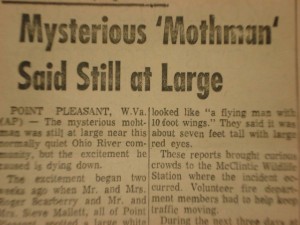
In the beginning, there were only “big birds.”
Couple See Man-Sized Bird…Creature…Something blared the Point Pleasant Register on November 16, 1966.
City Get ‘The Bird,’ Want It Or Not stated the headlines of the Point Pleasant Register on November 17, 1966.
Couples Say They Saw 6-Ft. 100-mph ‘Bird’ noted the UPI, in the following days, across the nation, beginning on November 18, 1966.
Our ‘Bird’ Has Law On Its Side claimed the Point Pleasant Register on November 18, 1966.
By mid-December 1966, with John A. Keel in town investigating and Mary Hyre placing paranormal elements in her columns while diminishing the earlier “Big Bird” details, the media began to change their focus. Yes, indeed, it was during this period when that unnamed copyeditor in Ohio started using the name “Moth Man” and then “Mothman.” The more bird-like elements of the reports disappeared, and the natural history links morphed into a stranger and weirder entity.
Although I think John Frick has made his point, I still contend a sociological evolution occurred. The earlier more avian elements began to be discharged in favor of a more sinister “man-like” creature. This happened with allusions to science fiction movies and strange lights in the skies, especially cropping up after John A. Keel, for the first time, arrived in Point Pleasant, interestingly, on “Pearl Harbor Day,” Wednesday, December 7th, 1966.
Later, the headlines for the town in December 1967 would take on part two of the saga of Mothman.
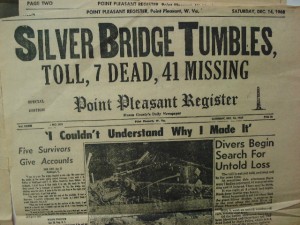
About Loren Coleman
Loren Coleman is one of the world’s leading cryptozoologists, some say “the” leading living cryptozoologist. Certainly, he is acknowledged as the current living American researcher and writer who has most popularized cryptozoology in the late 20th and early 21st centuries.
Starting his fieldwork and investigations in 1960, after traveling and trekking extensively in pursuit of cryptozoological mysteries, Coleman began writing to share his experiences in 1969. An honorary member of Ivan T. Sanderson’s Society for the Investigation of the Unexplained in the 1970s, Coleman has been bestowed with similar honorary memberships of the North Idaho College Cryptozoology Club in 1983, and in subsequent years, that of the British Columbia Scientific Cryptozoology Club, CryptoSafari International, and other international organizations. He was also a Life Member and Benefactor of the International Society of Cryptozoology (now-defunct).
Loren Coleman’s daily blog, as a member of the Cryptomundo Team, served as an ongoing avenue of communication for the ever-growing body of cryptozoo news from 2005 through 2013. He returned as an infrequent contributor beginning Halloween week of 2015.
Coleman is the founder in 2003, and current director of the International Cryptozoology Museum in Portland, Maine.
Filed under Avian Mysteries, Bigfoot, Cryptomundo Exclusive, Cryptotourism, CryptoZoo News, Eyewitness Accounts, Mothman, Pop Culture, Winged Weirdies, Year In Review